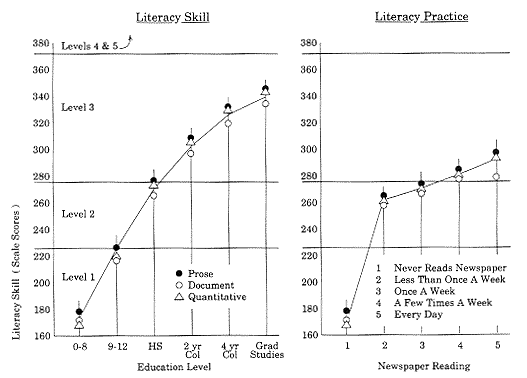|
National Adult Literacy Survey - 1993 In 1993 the National Center for Education Statistics of the U. S. Department of Education reported the results of a survey of the literacy skills of adults aged 16 to over 65 living in households in the United States. Additionally, the survey studied the literacy skills of incarcerated adults. The National Adult Literacy Survey (NALS) used the same prose, document, and quantitative scales as used in the Young Adult Literacy Survey (YALS). Many of the same test items as were used in the YALS were also used in the NALS. Pages 100 through 112 present samples of items from the YALS that were also used in the NALS. Additional items were also developed for the NALS. Literacy scores were reported using the scale scores for the three different domains of literacy tasks: prose, document, and quantitative. Just as with the YALS, the scale scores used in the NALS for each of the three different types of literacy task domains ranged from 0 to 500, with the majority of tasks (items) falling between 200 and 400. The 1993 report of the NALS available at the time this report was prepared did not give data on the percent of young adults who performed various literacy tasks correctly. Nor did the report indicate how literacy practices varied as a function of years of education. Therefore, to show how performance on the NALS compares with earlier adult literacy assessments, the left side of figure 82 shows skill levels on the prose, document, and quantitative tasks in terms of scale scores for people at different levels of education. The figure also shows on the right how scale scores varied for people who engaged in various amounts of one literacy practice: newspaper reading. Both the skill and practices data resemble the findings of Buswell in 1937 (page 43), the Adult Functional Reading Study of 1973 (page 63) and the Young Adult Literacy Survey (page 99) in showing that people with more education have higher reading skills, and that people who read the newspaper more also have higher reading skills. This confirms the earlier findings that skill, practice and education are interrelated. Future reports from the NALS are planned that will discuss additional relationships among education, literacy skills, and literacy practices.

|
||||